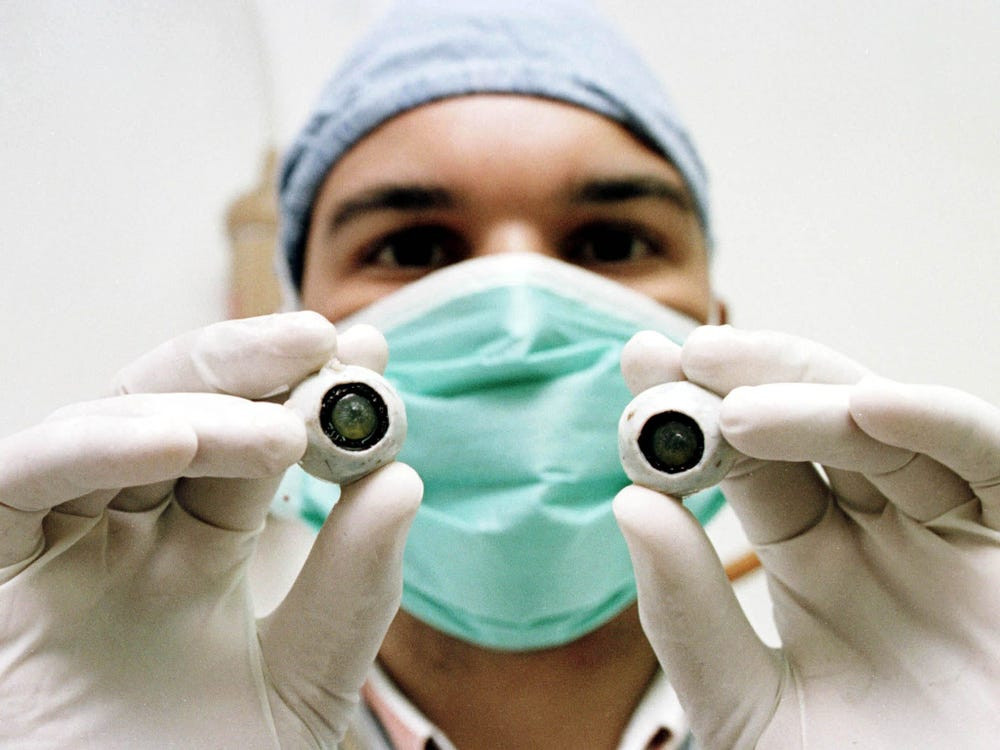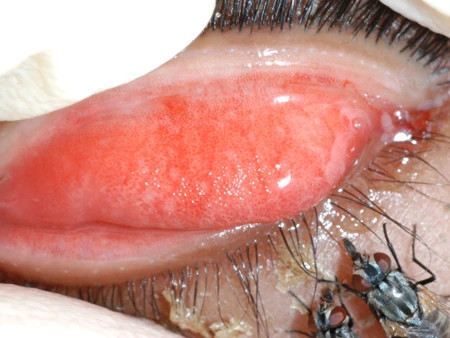Definition
Endophthalmitis refers to an inflammatory condition affecting the internal structure of the eye, typically resulting from an infection. This infection may originate either internally or externally, with a frequent occurrence following ocular surgeries, particularly cataract procedures. The incidence of endophthalmitis after the cataract surgery ranges from 0.08% to 0.68%, accounting for approximately 60% of all endophthalmitis cases. In contrast, endogenous infections (those originating within the body) are uncommon, representing only about 2% to 15% of all endophthalmitis cases.
Causes
Endophthalmitis can arise from bacterial or fungal infections. Gram-positive bacteria, such as Staphylococcus epidermidis and Staphylococcus aureus, are commonly implicated in postoperative cases, while Gram-negative bacteria, including Pseudomonas, Escherichia coli, and Enterococcus, are frequently associated with stab wounds. Fungal infections, particularly those caused by Candida albicans, are also a notable cause.
Infections leading to endophthalmitis can be categorized as either endogenous (originating within the body) or exogenous (originating outside the body). Under normal circumstances, the eye possesses a defense mechanism that prevents bacterial or fungal invasion. In endogenous infections, pathogens may breach the eye’s defenses by directly damaging the blood-ocular barrier or by releasing substances that alter the structure of the inner vascular layers. Conversely, in exogenous infections, pathogens can invade the eye due to trauma, foreign bodies, surgical procedures, or drug injections.
Besides infections, endophthalmitis may also result from toxic agents or residual lens fragments following cataract surgery.
Risk Factors
Risk factors for endogenous endophthalmitis include infections in other parts of the body, such as:
- Endocarditis (inflammation of the inner heart lining)
- Meningitis (inflammation of the brain lining)
- Urinary tract infections
- Compromised immune systems, such as in HIV/AIDS
- Diabetes mellitus
- Prolonged use of immunosuppressive drugs
On the other hand, risk factors for exogenous endophthalmitis include:
- Penetrating eye injuries
- History of cataract surgery, especially within one week postoperatively
- Intraocular drug injections
- Exposure to toxic substances
Symptoms
Individuals with endophthalmitis typically present with symptoms of eye redness and blurriness. Additionally, they may experience ocular pain, headaches, fever, photophobia, and discharge resembling pus. This condition usually affects only one eye.
In postoperative cases, the infection generally manifests within one week of surgery, although delayed presentations can occur months or even years later. In bacterial endophthalmitis, the most frequent symptoms are eye pain, redness, eyelid swelling, and a sudden decrease in visual acuity.
In fungal endophthalmitis, the most prevalent symptoms include prolonged blurred vision and pain lasting several days to weeks. In cases of Candida fungal infections, fever may precede the onset of ocular symptoms.
Diagnosis
Endophthalmitis is typically diagnosed by a doctor through a series of examinations. The assessment includes evaluating visual acuity, measuring intraocular pressure, and conducting both external and internal eye examinations. The external examination aims to detect signs such as eyelid swelling, conjunctival injection (appearance of blood vessels in the eye), and the presence of hypopyon (a pus-like layer in the anterior chamber of the eye). Internal eye examination, which can be performed using techniques such as funduscopy or slit-lamp biomicroscopy, is conducted to assess the clarity of the vitreous humor and detect any decrease in the red reflex. During this examination, cotton-wool spots and debris may also be observed within the vitreous cavity.
In addition to the physical examination, the doctor may order several diagnostic tests to support the diagnosis, including:
- Complete blood count with blood differential to check the presence of an infection
- Culture of intraocular fluids to identify the causative pathogen
Depending on the patient's symptoms and medical history, additional tests may be required:
- Kidney function tests if there is a history of renal disease or diabetes
- Chest X-ray and echocardiogram if a cardiac infection is suspected
- Cerebrospinal fluid culture if there is suspicion of meningitis
- Blood cultures if the patient presents with fever of unknown origin
- Throat swab culture if a pharyngeal infection is suspected
- Culture of foreign matters involved in penetrating eye injuries
- Urine culture if a urinary tract infection is suspected or the infection source is unidentified
- Stool culture if a gastrointestinal infection is suspected
Management
The treatment approach for endophthalmitis varies depending on the etiological agent and associated risk factors. Generally, the cornerstone of therapy is the administration of antibiotics. In postoperative cases, management may involve the removal of infected intraocular fluids, coupled with the injection of antibiotics directly into the eye. For cases related to trauma, surgical intervention may be necessary to remove foreign bodies or repair the injured eye, alongside intraocular antibiotic administration and tetanus prophylaxis. In instances of endogenous infection, treatment involves the administration of broad-spectrum antibiotics, delivered directly into the eye. For fungal infections, antifungal agents can be administered orally, intravenously, or directly into the eye.
The prognosis of endophthalmitis largely depends on the virulence of the infecting organism, the degree of visual impairment at the time of diagnosis, and the timeliness of initiating treatment. Endogenous endophthalmitis generally has a poorer prognosis compared to exogenous cases, primarily due to the involvement of more virulent pathogens and the often-compromised immune status of the patient, as seen in conditions like diabetes, HIV/AIDS, or prolonged use of immunosuppressants.
The level of visual acuity at the time of diagnosis is a critical determinant of the visual outcome; the lower the visual acuity initially, the less favorable the visual outcome is likely to be after treatment. Early initiation of therapy is associated with better outcomes, whereas delayed treatment, often due to late diagnosis, increases the risk of severe complications.
Complications
If left untreated, endophthalmitis can lead to severe complications, such as permanent visual loss, blindness, deformation of the eye, and the necessity for enucleation, a procedure involving the removal of the eye while preserving the surrounding muscles and tissues.
Prevention
Preventive measures for endophthalmitis involve minimizing exposure to risk factors, such as:
- Preventing diabetes through dietary management, regular exercise, and maintaining an optimal body weight
- If diagnosed with diabetes, controlling blood sugar levels with regular medication and monitoring
- Preventing HIV/AIDS by avoiding multiple sexual partners and refraining from illicit drug use
- If diagnosed with HIV/AIDS, adhering to antiviral treatments as prescribed by a healthcare provider
- For individuals working in occupations with a high risk of ocular exposure to foreign objects (such as blacksmiths, farmers, or chemical factory workers), wearing protective eyewear is essential
When to See a Doctor?
Immediate medical attention should be sought if symptoms such as the following are experienced:
- Eye redness accompanied by vision loss
- Ocular pain
- Swollen eyelids
- Purulent discharge from the eyes
- History of cataract surgery
- Exposure to a foreign body in the eye
These symptoms warrant an urgent visit to the nearest emergency department. A general practitioner will typically refer the patient to an ophthalmologist for specialized examination and management. Prompt diagnosis of endophthalmitis is crucial to initiate treatment and prevent complications.
Looking for more information about other diseases? Click here!
- dr Hanifa Rahma
Kamjoo, S., Xu, D., Melendez, R., Shah, V., Tripathy, K., & Hossain, K. et al. (2021). Endophthalmitis. Retrieved 12 October 2021, from https://eyewiki.aao.org/Endophthalmitis.
Egan, D., Peters, J., Peak, D., & Semple, J. (2018). Endophthalmitis. Retrieved 12 October 2021, from https://emedicine.medscape.com/article/799431-overview.










